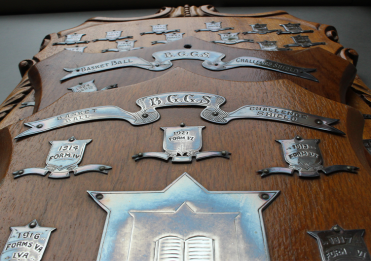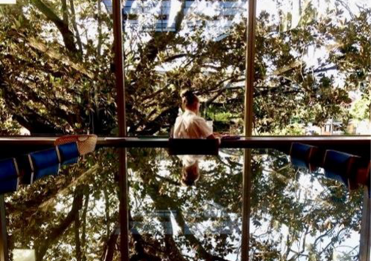The Libellum Society, whose name derives from the Latin word meaning ‘little book’, is the Girls Grammar book club that, for the past 22 years, has met weekly to preview new fiction and other titles purchased by the Beanland Memorial Library, as well as provide an opportunity to organise participation in writers’ festivals, book launches, literary events, and writing competitions. The Society was established in 2001 by teacher librarian, Ms Robin Farr, and when Mrs Kristine Cooke, former Director of Library and Information Services, assumed the role of Coordinator in 2008, the student members selected the name.
The leader of the group in 2008, Alexandra Markey (2008), led the girls to promote a competition to design a bookmark for the library to celebrate the 50-year anniversary of the library on its site. The competition produced a bookmark designed by Shiromani Singh (2009), which would later become the Libellum Society’s logo. Shiromani adapted a frieze design entitled, ‘The Junior’, by Evelyn (Lesly) Marsland (1936) from the 1934 School magazine. Shiromani’s design combined the original black and white frieze drawing with computer art.

Evelyn (Lesly) Marsland (IV B), 1934

Shiromani Singh’s (2009) design for the Libellum Society, 2008
Researching the Libellum Society frieze design led to a serendipitous discovery of a 1928 art book in the School’s collection, and the revelation of an inspirational art teacher and artist whose legacy leaped from its pages.
Frieze, or tile design, was, for more than 40 years, an integral part of the Girls Grammar curriculum and a reflection of the evolving trends in Western art and modernity in the nineteenth and early twentieth century (Martin, 2017). Frieze illustrations first appeared as ‘original designs’ in the Girls Grammar Bi-Annual Magazine in 1933, so Lesly’s was one of the very early designs. Lesly’s mother, Charlotte Marsland (Hyde, 1913), also attended Girls Grammar, and Lesly was still a ‘junior’ in form IV B when she created the frieze—perhaps she was feeling the weight of her position.
Frieze design is a technique of ‘ornamentation’ which has its origins in classical antiquity, and enjoyed a renewed interest in the nineteenth century (Martin, 2017). A frieze, or ornament, ‘is a decoration or embellishment (that provides) additional detail added to an object, interior or architectural structure which serves no other purpose than to make it more interesting, arresting or beautiful’ (Grant, 2011). English architect, graphic designer, and theorist of ornament, Owen Jones, saw the divine in the ordered structures evident in nature. His achievements include the decoration of the Crystal Palace of the Great Exhibition of 1851 (The University of Melbourne, 2023).

The Grammar of Ornament: A Visual Reference of Form and Colour in Architecture and the Decorative Arts
Jones, like many of his English contemporaries, was concerned by the poor quality of British design and having gained his inspiration for design from his travels and the Great Exhibition, saw the potential of ornamentation offered by the advances of the Industrial Revolution (Zaczek, 2000). The pinnacle of his work was the publication of his book, The Grammar of Ornament: A Visual Reference of Form and Colour in Architecture and the Decorative Arts (1856), which was simply meant to be a textbook about the principles of the language of ornamentation—structured, patterned, natural, decorative (Martin, 2017). Owen’s book was hugely influential on the Arts and Crafts movement of the nineteenth century and informed the work of artists such as William Morris (1834-1896), architect, Frank Lloyd Wright (1867-1959), and Girls Grammar’s first Art teacher, Miss Vera Cottew (Zaczek, 2000).
Miss Cottew was an artist and Art teacher who commenced as a Visiting Mistress of Drawing at Girls Grammar in 1925, after spending three years as an Art teacher at Somerville House. She dedicated the next 22 years of her career to Girls Grammar (Lilley, 1926).
Shortly after her employment, Miss Cottew acquired her own copy of The Grammar of Ornament, a 1928 reprint of the 1910 edition, A3 in size, leather bound with a gold-leaf gilded edge, containing 100 chromolithograph plates. It must have been very exciting to have such a magnificent book that had been described as ‘beautiful enough to be the hornbook of angels’ (Zaczek, 2000). Miss Cottew used it with passion, passing on Owen’s aesthetic language to her young students in her drawing classes.

Indian No 4, Plate LII from Vera Cottew’s copy of 'The Grammar of Ornament'

Chinese No 3, Plate LXI from Vera Cottew’s copy of 'The Grammar of Ornament'
Reflections of Owen’s dynamic colour plates are evident in the students’ geometric friezes and Grecian themed designs published as a full page (page 17) in the 1933 School Magazine. In the following year, Miss Cottew taught the girls how to find patterns in nature, using this as the inspiration for their designs. Joan Elliot’s (Clowes, 1937) ‘flying fish’ design and Jean Parnell’s (1937) circular floral motive reveal this instruction.

Joan Clowes (III D), 1934 December School Magazine, p20

Jean Parnell (III D), 1934 June School Magazine, p30
By 1934, Miss Cottew was clearly having success with her students. Irene Hingston (1937) revealed a sophisticated peacock-like pattern, as does Evelyn Marsland’s (1936) drawing of Grammar girls sitting studiously beside their tower of books that are topped with ink wells and paper.

Irene Hingston (III C), 1934 December School Magazine, p20

Evelyn (Lesly) Marsland (IV B), 1934 December School Magazine, p14
Grammar girls in action appeared as a theme in later frieze designs, which displayed girls in their sports tunics participating in dance (Judith Smith [Clowes, 1941]), or in formal School uniform leisurely reading (Patricia Tompkins [Lahey, 1941]) or demonstrating gymnastics routines (Colleen Kronk [Gregg, 1944]). Like the revelation of an ancient Roman mosaic, the Girls Grammar students’ tiles provide a window into the past, confirming the School uniforms of their era, hairstyles, and their activities.

Judith Clowes (III E), 1938 June School Magazine, p19

Patricia Lahey, 1939 June School Magazine, p35

Colleen Juanita Gregg (IV A), 1942 December School Magazine, p29
The designs also reveal the influential art movements of their day, such as the Art Deco movement of the 1930s and 1940s, as evident in Betty Nobbs’ (1940) gothic cityscape. Other tiles were more whimsical, featuring playful images of rabbits, ducks (Betty Young, 1941), and Australian wildlife. One wonders if the task set was to create a frieze that would be the ornamentation for a child’s nursery.

Betty Nobbs (IV A), 1938 June School Magazine, p34

Betty Young (III B), 1938 December School Magazine, p39
After 1930, ‘Drawing’ became known as Senior Art, and from 1934 the lower Forms took Junior Art. Miss Cottew was a beloved teacher, and Head Mistress, Ms Kathleen Lilley, noted in the Confidential Book: ‘Appointed July 1925. Teaches freehand drawing, design, painting, and the history of art … doing excellent work, from which her pupils get much pleasure … Miss Cottew misses no opportunity for encouraging her pupils—takes large groups to see new buildings, and art exhibitions, to illustrate her lessons given in the art room’.
Frieze design continued to be included in the Art Curriculum with the tiles becoming quite psychedelic by the 1960s and 1970s. The last tile appeared in the 1974 School Magazine, reflecting a mandala design rather than a tile.

Anna Torenbeek (IV B), 1971 School Magazine, p.39
Miss Cottew’s dedication reflected her personal pursuit as a practicing artist. She was recorded in the 1941 Meanjin papers delivering a presentation on ‘Recent Aspects of Australian Art’ at the July meeting of the Queensland Authors and Artists’ Association (Meanjin Papers, 1941). Grammar Woman and Australian poet, Gwendoline Harwood (Foster, 1937), remembered her childhood teacher with fondness, referencing her Art teacher’s sculpture room and still life arrangements in her poetry (Golsby-Smith, n.d.). By her final year at Girls Grammar in 1947, Miss Cottew had progressed to position of assistant Mistress and was also teaching at the Teachers’ Training College in Brisbane.

Studies in still life, Senior Art class, 1939

1939 Vera Cottew with students Ethel Holyoake (behind), and two other students on the stairs of the Western Wing
In the annual report of 1950, Kathleen Lilley reported: ‘I also record with deep regret the death of Miss Vera Cottew, who was from July 1926 to February 1948 a valued member of our teaching staff and a kind, good colleague. Miss Cottew has bequeathed to the School some of her Art books which we will treasure for her sake as well as for their own value’ (Lilley, 1950). The Courier-Mail praised Miss Cottew’s legacy, noting ‘she gave public exhibitions of her paintings, which were also exhibited in The Courier-Mail Art Panel … Many of her pupils hold prominent positions in Queensland’s secondary schools, and several are completing their art training overseas’ (The Courier-Mail, 1950). Gwen Harwood paid tribute to her teacher penning the poem, Nightfall: To the memory of Vera Cottew.

Vera Cottew’s signature in her copy of 'The Grammar of Ornament' gifted to the School
Of Miss Cottew’s bequests, the most magnificent is her book, The Grammar of Ornament. Quite serendipitously, this incredible text was recently found in the Beanland Library collection not having been borrowed for many years. Inside the front cover, we were delighted to discover Miss Cottew’s signature.
The first students to enjoy this rediscovery were members of the Libellum Society, whose logo is a direct representation of Miss Cottew’s dynamic contribution to the Creative Arts at Girls Grammar. The book is now valued at $1200, but its historical value is far greater. It has been almost 100 years since Miss Cottew began educating Grammar girls and instilling in them a deep appreciation of the relationship between nature and artistic expression. Such a rich history has been revealed in the layers of the student designs, the imagination of a dedicated teacher, and the wonderful book that she left behind.

2023 Libellum Society Captain, Charlotte Wilson (9G) holds Vera Cottew’s bequest, 'The Grammar of Ornament'
Ms Rachael Christopherson
Director of Library and Information Services
References
AbeBooks. (2023, July 28). The Grammar of Ornament: A Visual Reference of Form and Colour in Architecture and the Decorative Arts. Retrieved from AbeBooks: https://www.abebooks.com
Golsby-Smith, S. (n.d.). In her father’s house: Gwen Harwood as a sacramental poet. JASAL, 1 – 13.
Grant, S. (2011, September 29). What is ornament, what is an ornament print and why do they matter? Retrieved from VAM: https://www.vam.ac.uk/blog/engraved-ornament-project/what-ornament-what-ornament-print-and-why-do-they-matter
Lilley, K. M. (1926). Brisbane Girls Grammar School Annual Report. Brisbane: Brisbane Girls Grammar School.
Lilley, K. M. (1950). Report for the Year 1950. Brisbane: Brisbane Girls Grammar School.
Martin, A. D. (2017, February 22). The Language of Ornament. Retrieved from NGV: https://www.ngv.vic.gov.au/essay/the-language-of-ornament/
Meanjin Papers. (1941, June). News Reels. Meanjin papers. Brisbane, Queensland, Australia: Clement Byrne Christesen.
The Courier-Mail. (1950, October 30). Artist dead. The Courier-Mail, p. 6.
The University of Melbourne. (2023, August 1). The Grammar of Ornament by Owen Jones. Retrieved from Archives and Special Collections: https://library.unimelb.edu.au/asc/teaching-and-learning/objects/the-grammar-of-ornament
Zaczek, I. (2000). Introduction. In O. Jones, The Grammar of Ornament: A Visual Reference of Form and Colour in Architecture and the Decorative Arts (pp. 12 – 17). London: Bernard Quaritch.

1933 December School Magazine p.27




